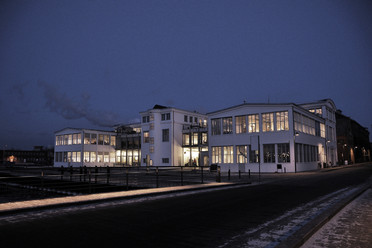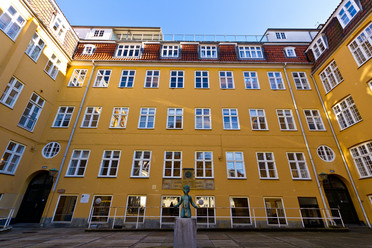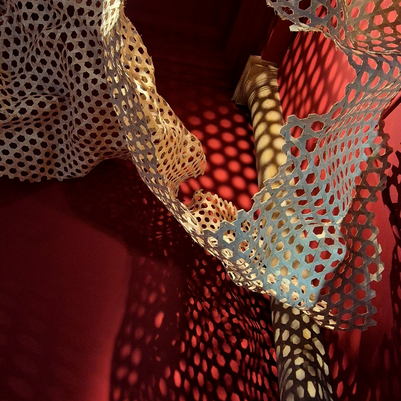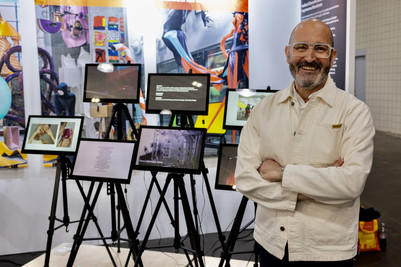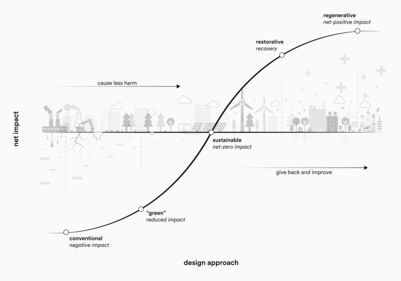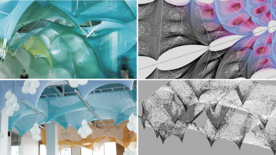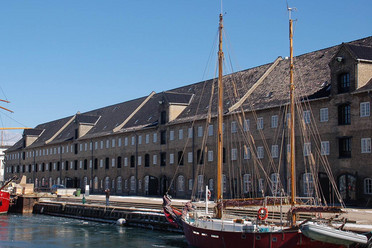
The CEPHAD Bibliography on the philosophy of design
How to use the bibliography
If you are looking for publications by a particular author, or for a particular title or keyword, open all the Collapsed elements and use your browser's search-on-page command.
The reverse chronological order of the sections below gives you a sense of the historical development of the field, and allows you to start your search for literature with the most recent items. Newcomers to the field should note, however, that early literature may be highly relevant; e.g., the books by Schön (1983) and Simon (1969/1996) are frequently cited even today.
References & links
Entries are formatted in APA style (though italics are missing in some of the older entries), and listed in lexicographical order within each section.
Editorial policy for the CEPHAD Bibliography
Editorial policy for the CEPHAD Bibliography
With good help from our users who submit proposals for new material, we make a serious effort to ensure that the bibliography gradually becomes more and more complete and up to date.
Completeness is not sought at the expense of quality and focus, however. We reserve the right to include or exclude material according to our best editorial judgement.
In making that judgement, we try to be reasonably broad-minded as to what counts as philosophy of design, since we acknowledge that no generally accepted and clear-cut definition exists. (In particular, we do not limit ourselves to any particular philosophical method or tradition.) Yet to help us decide consistently, we employ the following editorial guidelines.
To be eligible for inclusion, a publication must meet Conditions 1 and 2, and be satisfactory with respect to quality (Criterion 1) and focus (Criteria 2 and 3). Trade-offs can be made among the criteria.
- Condition 1: It conforms to minimal standards of scholarship.
- Condition 2: It conveys insights about designing through philosophical means. (It need not be dedicated to this subject, but should contain at least one passage addressing the subject in more than a superficial way.)
- Criterion 1: The degree to which it exhibits more than minimal academic quality. For instance, with respect to originality, depth of thought, implications of contribution, and clarity.
- Criterion 2: The degree to which it deals with problems of genuine philosophical interest.
- Criterion 3: The degree to which it deals with a prototypical conception of designing: as an act of devising or documenting a course of action that aims at production of an artefact. Artefacts may be material as well as immaterial.
Reviews of publications already included, may be included as well.
2011
2011
- Crilly, N. (2011). The design stance in user-system interaction. Design Issues, 27(4), 16-29. doi:10.1162/DESI_a_00102 [First page (free); full text (subscription / payment)]
- d'Anjou, P. (2011). An alternative model for ethical decision-making in design: A Sartrean approach. Design Studies, 32(1), 45-59. doi: 10.1016/j.destud.2010.06.003
[Abstract (free); full text (subscription / payment).] - Galle, P. (2011). Foundational and instrumental design theory. Design Issues, 27(4), 81-94. doi:10.1162/DESI_a_00107 [First page (free); full text (subscription / payment)] [Full text. (Free: Author's accepted manuscript).]
- Pols, A. J. K. (in press, 2011). Characterising affordances: The descriptions-of-affordances-model. Design Studies(0). doi: 10.1016/j.destud.2011.07.007 [Abstract (free); full text (subscription / payment).]
2010
2010
- Crilly, N. (2010). The roles that artefacts play: technical, social and aesthetic functions. Design Studies, 31(4), 311-344. [Abstract (free); full text (subscription / payment).]
- Folkmann, M. N. (2010). Evaluating aesthetics in design: A phenomenological approach. Design Issues, 26(1), 40-53. [First page (free); full text (subscription / payment)]
- Galle, P. (2010). Elementer af en fælles designfaglig videnskabsteori [Elemenets of a common theory of science for design; in Danish]. FORMakademisk, 3(2), 51-76. Available from http://www.formakademisk.org/index.php/formakademisk/article/view/70
- Galle, P. (Ed.). (2010). CEPHAD 2010 // The borderland between philosophy and design research // Plenary sessions & supplementary items of the CEPHAD 2010 Conference // Copenhagen // January 26th - 29th, 2010 // Copenhagen Working Papers on Design (Vol. 2010 no. 2). Copenhagen: The Danish Design School Press.
- Galle, P. & Hove, H. (Eds.). (2010). CEPHAD 2010 // The borderland between philosophy and design research // Regular table sessions & master class sessions of the CEPHAD 2010 Conference // Copenhagen // January 26th - 29th, 2010 // Copenhagen Working Papers on Design (Vol. 2010 no. 1). Copenhagen: The Danish Design School Press.
- Houkes, W., & Vermaas, P. E. (2010). Tecnnical Functions. On the Use and Design of Artefacts. Dordrecht: Springer. [Publilsher's info.]
- Poel, I. v. d., & Goldberg, D. E. (Eds.). (2010). Philosophy and Engineering. An Emerging Agenda. Dordrecht: Springer. [Publisher's info.]
2009
2009
- Chua, S. M. J. (2009). Donald Schön, Herbert Simon and The Sciences of the Artificial. Design Studies, 30(1), 60-68. [Abstract (free); full text (subscription / payment).]
- d'Anjou, P. (2009). Beyond duty and virtue in design ethics. Design Issues, 26(1), 95-105. [First page (free); full text (subscription / payment)]
- Franssen, M., Lokhorst, G.-J., & van de Poel, I. (2009). Philosophy of technology. Stanford Encyclopedia of Philosophy (Falll 2009 Edition), retrieved November 4, 2009, from http://plato.stanford.edu/archives/fall2009/entries/technology/ [see especially section 2].
- Galle, P. (2009). The ontology of Gero's FBS model of designing. Design Studies, doi:10.1016/j.destud.2009.02.002. [Abstract (free); full text (subscription / payment).] [Full text (free: author's accepted manuscript).]
- Lloyd, P. (2009). Ethical imagination and design. Design Studies, 30(2), 154-168. doi: 10.1016/j.destud.2008.12.004 [Abstract (free); full text (subscription / payment).]
2008
2008
- Crilly, N., Good, D., Matravers, D., & Clarkson, P. J. (2008). Design as communication: exploring the validity and utility of relating intention to interpretation. Design Studies, 29, 425-457. [Abstract (free); full text (subscription / payment).]
- Galle, P. (2008). Candidate worldviews for design theory. Design Studies 29 (3) 267-303. [Abstract (free); full text (subscription / payment).] [Full text (free: author's accepted manuscript).]
- Haynes, S. R. & Carroll, J. M. (2008). Theoretical design science in human-computer interaction: a practical concern? Artifact, 1 (3), 159-171. [Abstract (free); full text (subscription / payment).]
- Latour, B. (2008). A cautious Prometheus? A few steps toward a philosophy of design (with special attention to Peter Sloterdijk). Keynote lecture for the Networks of Design meeting of the Design History Society, Falmouth, Cornwall, September 3rd, 2008. Retrieved 2009-08-14 from http://www.bruno-latour.fr/articles/index.html.
- Parsons, G., & Carlson, A. (2008). Functional Beauty. Oxford: Oxford University Press. [Publisher's info.]
- Redström, J. (2008). RE: Definitions of use. Design Studies 29 (3) 410-423. [Abstract (free); full text (subscription / payment).]
- Vermaas, P. E., Kroes, P., Light, A. & Moore S. A. (eds.). (2008). Philosophy and Design. From Engineering to Architecture. Springer Science.
2007
2007
- Cross, N. (2007). Book Review: Klaus Krippendorff, The Semantic Turn: A New Foundation for Design, Taylor and Francis CRS Press, Boca Raton, Florida, USA (2006). Design Studies, 28 (1), 107-108. [Full text (subscription / payment).]
- Dong, A. (2007). The enactment of design through language. Design Studies, 28 (1), 5-21. [Abstract (free); full text (subscription / payment).]
- Friedman, K. (2007). Book Review: Nigel Cross, Designerly Ways of Knowing, Springer Verlag, London (2007). Design Studies, 28 (1), 103-104. [Full text (subscription / payment).]
- Krippendorff, K. (2007). An exploration of artificiality. Artifact, 1 (1), 17-22. [Full text (free).]
- Laurence, S. & Margolis, E. (Eds.). (2007). Creations of the Mind: Essays on Artifacts and their Representations. Oxford: Oxford University Press. [The book deals with artefacts from four different points of view: the metaphysical, the conceptual, the cognitive, and the evolutionary / historic. Authors include philosophers, psychologists and cognitive scientists.]
- Redström, J. (2007). Left to our own devices. Artifact, 1 (1), 26-28. [Full text (free).]
- Vermaas, P. E. & Dorst, K. (2007). On the conceptual framework of John Gero’s FBS-model and the prescriptive aims of design methodology. Design Studies, 28 (2), 133-157. [Abstract (free); full text (subscription / payment).]
2006
2006
- Cross, N. (2006). Designerly ways of knowing. London: Springer. [This book is based on a series of articles beginning with (Cross, 1982). The approach is often philosophical and metatheoretical. Topics include: the nature of design ability, cognition, and expertise; design as a discipline, and its relation to science. See also review by Friedman (2007).]
- Dearden, A. (2006). Designing as a conversation with digital materials. Design Studies, 27 (3), 399-421. [Abstract (free); full text (subscription / payment).]
- Dorst, K. (2006). Design problems and design paradoxes. Design Issues, 22 (3), 4-47. [Full text (subscription / payment).]
- Galle, P. (2006). Worldviews for design theory. In Friedman, K., Love, T., Côrte-Real, E., & Rust, C. (Eds.) Design Research Society. Wonderground. International conference 2006. Lisbon: IADE - Instituto de Artes Visuais, Design e Marketing. Abstract (free) and main text (free) retrieved on June 28, 2007 as separate pdf-files from http://www.iade.pt/drs2006/wonderground/proceedings/index.html - Search for paper 126. [ Abstract & TOC of preprint (free). Keywords: Design theory and research, philosophy of design, metatheory.]
- Jonas, W. (2006). A special moral code for design? Design Philosopy Papers 2/2006. Retrieved January 3, 2007, from http://www.desphilosophy.com/dpp/home.html.
- Krippendorff, K. (2006). The semantic turn: a new foundation for design. Boca Raton, FL: CRC Press, Taylor & Francis Group. [Proposes paradigmatic shift in the conception of design, emphasizing the designed artefact’s individual and cultural meaning. User-centred design is a central idea. A new ‘science for design’ is outlined and contrasted to ‘science of design’ and ‘design science’ (Cross, 2001). Philosophical contributions include conceptual clarification and development of design thinking, and the application of philosophy of science to the knowledge on which design as a profession relies. See also review by Cross (2007).]
- Michl, J. (2006, August). Without a godlike designer no designerlike God. Design and Evolution. Conference organized by Design History Society, Delft University of Technology and the Henri Baudet Institute, Delft, Holland. Retrieved March 23, 2007, from http://www.geocities.com/Athens/2360/eng.intelligent.html [work in progress, according to author].
- Pan, En-rong (2006). Base & significance of philosophy of design - naturalistic cognition. (In Chinese.) Journal of Dialectics of Nature, 28 (5), 43-47. [Chinese web page of this issue.]
- Redström, J. (2006). Towards user design? On the shift from object to user as the subject of design. Design Studies, 27 (2), 123-139. [Abstract (free); full text (subscription / payment).]
2005
2005
- Bürdek, B. E. (2005). Design. History, theory and practice of product design. Basel: Birkhäuser. [Strictly speaking, this book does not contribute directly to the philosophy of design. However, its two chapters on methodology and on theory (pp. 225-342) contain many useful pointers to actual or potential links between design, design theory, and philosophy. Thus the book may nevertheless provide considerable guidance to workers in the field.]
- Coyne, R. (2005). Wicked problems revisited. Design Studies, 26 (1), 5-17. [Abstract (free); full text (subscription / payment).]
- Eir, A. (2005, July). On the ontological foundation for relating requirements and designs of artefacts. SPT Conference, July 20-22, Delft, NL. [Revised version in preparation. Retrieved March 22, 2007 from http://www.eir-home.dk/research/publications.html (pdf).]
- Östman, L. E. (2005). A pragmatist theory of design. (PhD dissertation, School of Architecture, Royal Institute of Technology, Stockholm, 2005). [The book does not focus on the philosophy of design as its primary subject, but the author applies John Dewey's philosophy to the development of empirically based design theory. (DKDS location: C10.02.)]
- Thomasson, A. L. (2005). Ingaqrden and the ontology of cultural objects. In A. Chrudzimski (Ed.), Existence, culture, and Persons: The Ontology of Roman Ingarden (pp 115-136). Frankfurt: Ontos.
- Thomasson, A. L. (2005). The ontology of art and knowledge in aesthetics. The Journal of Aesthetics and Art Criticism, 63 (3), 221-229.
- Verbeek, P.-P. (2005). What things do. Philosophical reflections on technology, agency, and design. Pennsylvania State University Press.
2004
2004
- Akin, Ö. (2004). A Cartesian Approach to Design Rationality. Ankara: METU Faculty of Architecture. [Turkish ISBN# 975-429-245-0. Summary retrieved March 8, 2007 from http://www.andrew.cmu.edu/user/burakpak/oa04/publications_books.html.]
- Eir, A. (2004). Construction Informatics - Issues in engineering, computer science, and ontology. Ph.D dissertation, Informatics and Mathematical Modelling, Technical University of Denmark, Lyngby, DK [Chapter 8, 'Object aspects' and chapter 9, 'Properties and design' specifically on the philosophy of design. Retrieved March 22, 2007 from http://www.eir-home.dk/research/philosophyofdesign.html (pdf).]
- Houkes, W. & Vermaas, P. (2004). Actions versus functions: a plea for an alternative metaphysics of artifacts. The Monist 87 (1), 52-71.
- Kroes, P., Franssen, M., Poel, I. v. d., & Ottens, M. (2004). Engineering systems as hybrid, socio-technical systems. Paper presented at Engineering Systems Symposium, Cambridge Mariott. Retrieved 2009-09-24, from http://www.tbm.tudelft.nl/live/pagina.jsp?id=718ebdcb-66eb-458c-ba9a-bae1fad90a86&lang=nl.
- Lenart, M. & Pasztor, A. (2004). On a Paradigm Shift in Design: Toward Constructivist Foundations. Retrieved January 4, 2007 from Florida International University, School of Computing and Information Sciences at http://www.cs.fiu.edu/~pasztora/design/2004/design-phil.pdf.
- Russell, K. (2004). Artefacts and affordance: the surface of meaning. Working Papers in Art and Design, 3. Retrieved January 2, 2007 from http://www.herts.ac.uk/artdes1/research/papers/vol3/krabs.html.
- Rønnau, A. (2004). Obscuring design philosophy through the misuse of physics. Design Philosophy Papers, 1/2004. Retrieved January 3, 2007 from http://www.desphilosophy.com/dpp/home.html.
2003
2003
- Bamford, G. (2003, September). Research, knowledge and design. Design + Research :: Project Based Research in Architecture. Second International Conference of the Association of Architecture Schools in Australasia. Retrieved March 27, from http://nla.gov.au/nla.arc-39710 via link "2003 Conference Proceedings".
- Bucciarelli, L. (2003). Engineering Philosophy. Delft: Delft University Press.
- Downton, P. (2003, September). Knowing practice: an inquiry into design research via making. Design + Research :: Project Based Research in Architecture. Second International Conference of the Association of Architecture Schools in Australasia. Retrieved March 27, from http://nla.gov.au/nla.arc-39710 via link "2003 Conference Proceedings".
- Friberg, C. (2003). Design og aestetik. Nogle filosofiske overvejelser. Nordisk Arkitekturforskning / Nordic Journal of Architectural Research, 16 (2), 19-25. ["Design and aesthetics. Some philosophical considerations", in Danish. Friberg contends that designed products grow from our fund of human experience, and affects it as well; and he argues that aesthetics, rather than narrowly focusing on art, as it tends to do by tradition, should take an interest in design and the role it plays in daily human practice. Everyday things reflect our basic understanding of the world in ways we are unawere of, he says, and it is a task for aesthetics to explore and explain how.]
- Friedman, K. (2003). Theory construction in design research: criteria, approaches, and methods. Design Studies, 24 (6), 507-522. [Abstract (free); full text (subscription / payment).]
- Newton, S. (2003). Designing as disclosure. Design Studies, 25 (1), 93-109. [Abstract (free); full text (subscription / payment).]
2002
2002
- Baljon, C. J. (2002). History of history and canons of design. Design Studies, 23 (3), 333-343. [Abstract (free); full text (subscription / payment).]
- Bamford, G. (2002). From analysis/synthesis to conjecture/analysis: a review of Karl Popper's influence on design methodology in architecture. Design Studies, 23 (3), 245-261. [Abstract (free); full text (subscription / payment).]
- Besteliu, I. & Doevendans, K. (2002). Planning, design and the post-modernity of cities. Design Studies, 23 (3), 233-244. [Abstract (free); full text (subscription / payment).]
- Biggs, M. (Ed.) (2002). Working Papers in Art & Design, 2. The concept of knowledge in art and design. Peer-reviewed papers from the Research into Practice conference 2002. Retrieved April 24, 2006 from http://sitem.herts.ac.uk/artdes_research/papers/wpades/vol2/index.html.
- Bucciarelli, L. L. (2002). Between thought and object in engineering design. Design Studies, 23 (3), 219-231. [Abstract (free); full text (subscription / payment).]
- Coyne, R., Park, H., & Wiszniewski, D. (2002). Design devices: digital drawing and the pursuit of difference. Design Studies, 23 (3), 263-286. [Abstract (free); full text (subscription / payment).]
- Galle, P. (2002). Philosophy of design: an editorial introduction. Design Studies, 23 (3), 211-218. [Abstract (free); full text (subscription / payment).]
- Galle, P. (Ed.) (2002). Design Studies, 23 (3). Special Issue on the Philosophy of Design. [All papers in this issue listed individually elsewhere in this bibliography. TOC (free); full text papers (subscription / payment).]
- Houkes, W., Vermaas, P. E., Dorst, K., & de Vries, M. J. (2002). Design and use as plans: an action-theoretical account. Design Studies, 23 (3), 303-320. [Abstract (free); full text (subscription / payment).]
- Kroes, P. (2002). Design methodology and the nature of technical artefacts.
Design methodology and the nature of technical artefacts.
Design Studies, 23 (3), 287-302. [Abstract (free); full text (subscription / payment).] - Michl, J. (2002). On seing design as redesign. An exploration of a neglected problem in design education. Scandinavian Journal of Design History, 12, 7-23. Retrieved March 23, 2007, from http://www.geocities.com/Athens/2360/eng.redesign.htm
- Nelson, H. G. & Stolterman, E. (2002). The Design Way: Intentional Change in an Unpredictable World: Foundations and Fundamentals of Design Competence. Educational Technology Publications. [ISBN: 978-0877783053. Reviews retrieved January 1, 2007, from http://www.advanceddesign.org/book.html.]
2001
2001
- Cross, N. (2001). Designerly ways of knowing: design discipline versus design science. Design Issues,17 (3), 49-55. Retrieved January 2, 2007, from http://oro.open.ac.uk/3281/
- Galle, P. (2001). Viewpoint: Metatheory in practice. Design Studies, 22 (1), 101-102. [This paper is a comment on (Love, 2000).]
- Technè Group. (2001). The Dual Nature of Technical Artifacts (Manifesto). Retrieved January 1, 2007 from the Delft University of Technology at http://www.dualnature.tudelft.nl/manifesto.htm. [The Dual Nature Project was part of a larger international research program, ‘Philosophical Foundations of Modern Technology’ jointly conducted by the departments of philosophy at Delft University of Technology, U. of Buffalo, MIT, Virginia Tech, Eindhoven U. of Technology, and Georgia Institute of Technology, over the period from April 2000 until the end of 2004. The site includes a list of publications.]
- Waks, L. J. (2001). Donald Schön's philosophy of design and design education. International Journal of Technology and Design Education, 11, 37-51.
2000
2000
- Durling, D. (2000). Reliable knowledge in design. Working Papers in Art and Design, 1. Retieved January 4, 2007 from http://www.herts.ac.uk/artdes/research/papers/wpades/vol1/durling2.html
- Durling, D. & Friedman, K. (Eds.) (2000). Doctoral Education in Design: Foundations for the Future. Stoke-on-Trent: Staffordshire University Press. [Proc. of a conference held 8-12 July 2000, in La Clusaz, France. ISBN 1-897898-64-9. Several relevant papers in this volume (under heading "Session 1"). Members of the Design Research Society have online access.]
- Galle, P. (2000). Call for papers: special issue on the philosophy of design. Design Studies, 21, 607-610.
- Love, T. (2000). Philosophy of design: a meta-theoretical structure for design theory. Design Studies, 21 (3), 293-313. [Abstract (free); full text (subscription / payment).]
1999
1999
- Flusser, V. (1999). The Shape of Things. A philosophy of Design. Reaktion Books. [ISBN: 1861890559.]
- Galle, P. (1999). Artefact specification, design and production as a process of communication. In Lasker, G. E. (Ed.), Advances in Systems Research and Cybernetics, Volæume III (InterSymp '99) (pp 58-62). Windsor: The International Institute for Advanced Studies in Systems Research and Cybernetics, and Society for Applied Systems Research. [Elaboration of model of design from (Galle, 1999, "Design as intentional action ..."), with a theory of communication as an additional theoretical framework. Introduces concept of "artefaction". Reprint available from CEPHAD (free).]
- Galle, P. (1999). Design as intentional action: a conceptual analysis. Design Studies 20 (1), 57-81. [Abstract (free); full text (subscription / payment).]
- Handa, R. (1999). Against arbitrariness: architectural signification in the age of globalization. Design Studies, 20 (4), 363-380. [Abstract (free); full text (subscription / payment).]
- Hilpinen, R. (1999). Artifacts. Stanford Encyclopedia of Philosophy (Fall 2008 Edition). Retrieved November 4, 2009, from http://plato.stanford.edu/archives/fall2008/entries/artifact/
- Liddament, T. (1999). The computationalist paradigm in design research. Design Studies, 20 (1), 41-56. [Abstract (free); full text (subscription / payment).]
1998
1998
- Rosenman, M. A. & Gero, J. S. (1998). Purpose and function in design: from the socio-cultural to the techno-physical. Design Studies, 19 (2), 161-186. [Abstract (free); full text (subscription / payment). On the ‘Function-Behaviour-Structure model of design’. See discussion of this model by Vermaas and Dorst (2007).]
- Schön, D. (1988). Designing: Rules, types and worlds. Design Studies, 9 (3), 181-190. [Abstract (free); full text (subscription / payment).]
- Tondl, L. (1998). Is it justified to consider the semiotics of technological artefacts? Poznan Studies in the Philosophy of the Sciences and the Humanities, 62, 375-395.
1997
1997
- Baljon, C. J. (1997). Viewpoint: Design justification as an instance of modal logic, or of rhetoric. Design Studies, 18 (1), 125-126. [Full text (subscription / payment). This paper is a comment on (Galle, 1996; 1997).]
- Biggs, M. (1997). Knowledge and advancement through models. Working Papers on Design, 1. Retrieved May 10, 2009 from http://sitem.herts.ac.uk/artdes_research/papers/wpdesign/vol1i.html.
- Eco, U. (1997). Function and sign: the semiotics of architecture. In N. Leach (Ed.), Rethinking Architecture. A Reader in Cultural Theory (pp. 182-201). New York: Routledge.
- Galle, P. (1997). In pursuit of the objects of designing. In Lasker, G. E. (Ed.), Research-In-Progress (InterSymp '97) (pp 46-50). Windsor: The International Institute for Advanced Studies in Systems Research and Cybernetics, and Society for Applied Systems Research. [Reprint available from CEPHAD (free).]
- Galle, P. (1997). Towards a formal logic of design rationalization. Design Studies, 18, 195-219. [Abstract (free); full text (subscription / payment).]
- Janlert, L. & Stolterman, E. (1997). The character of things. Design Studies, 18 (3), 297-314. [Abstract (free); full text (subscription / payment).]
1996
1996
- Denkel, A. (1996). Object and Property. Cambridge: Cambridge University Press. [A general discussion of the ontology of material objects. Of particular relevance to the philosphy of design: section 5.4 on form type vs. form token in artefacts.]
- Ekholm, A. (1996). A conceptual framework for classification of construction works. ITcon, 1. Retrieved January 04, 2007, from http://itcon.org/1996/2
- Galle, P. (1996). Design rationalization and the logic of design: a case study. Design Studies, 17, 253-275. [Abstract (free); full text (subscription / payment).]
- Liddament, T. (1996). The metamorphosis of the design vocabulary. Design Studies, 17 (3), 303-318. [Abstract (free); full text (subscription / payment).]
- Simon, H. A. (1996). The Sciences of the Artificial (3rd ed.). Cambridge MA: MIT Press. [1st ed. published 1969.]
1995
1995
- Michl, J. (1995). Form follows what? The modernist notion of function as a carte blanche. 1:50 - Magazine of the Faculty of Architecture and Town Planning, 10 [Technion Institute of Technology, Haifa, Israel], 20-31. Retrieved May, 14, 2006, from http://www.geocities.com/Athens/2360/jm-eng.fff-hai.html. [The author's analysis of the notion of function is relevant to the philosophy of artefacts, hence to the philosophy of design.]
- Roozenburg, N. F. M. & Eekels, J. (1995). Product Design: Fundamentals and Methods. Chichester: John Wiley & Sons. (Translated and revised version of ‘Produktontwerpen: Strucktuur en Methoden’, Utrecht: Uitgeverij Lemma B.V., 1991.)
1994
1994
- Sargent, P. (1994). Design science or nonscience. Design Studies, 15 (4), 389-402. [Abstract (free); full text (subscription / payment).]
1993
1993
- Coyne, R. & Snodgrass, A. (1993). Rescuing CAD from rationalism. Design Studies, 14 (2), 100-123. [Abstract (free); full text (subscription / payment).]
- Coyne, R. D. & Snodgrass, A. (1993). Cooperation and individualism in design. Environment and Planning B: Planning and Design, 20 (2), 163-174.
- Dipert, R. R. (1993). Artifacts, Art Works, and Agency. Philadelphia: Temple University Press.
- Galle, P. (1993). Review: 'From idea to building. Issues in architecture' by M Brawne; Butterworth Architecture, Oxford, 1992, 233 pages, 19.95 pounds. Environment and Planning B: Planning and Design, 20, 729-740. [On Popper's philosophy of science applied to architectural design. Reprint available from CEPHAD (free).]
- Hilpinen, R. (1993). Authors and artefacts. Proceedings of the Aristotelian Society, 93 (New Series), 155-178.
- O'Hear, A. (1993). Historicism and architectural knowledge. Philosophy, 68, 127-144.
- Oksala, T. (1993). Cognitive paradigms for design: knowledge, will, feeling and skill. In: M. R. Behesti & K. Zreik (Eds.), Advanced Technologies. Architecture. Planning. Civil Engineering (pp. 279-284). Proceedings of the Fourth EuropIA International Conference, Delft. Amsterdam: Elsevier
- Roozenburg, N. F. M. (1993). On the pattern of reasoning in innovative design. Design Studies, 14 (1), 4-18. [Abstract (free); full text (subscription / payment).]
1992
1992
- Buchanan, R. (1992). Wicked problems in design thinking. Design Issues, 8 (2), 5-21.
- Hertz, K. (1992). A coherent description of the process of design. Design Studies, 13, 393-410. [Abstract (free); full text (subscription / payment).]
- Hilpinen, R. (1992). On artifacts and works of art. Theoria, 58, 58-82.
1991
1991
- Coyne, R. & Snodgrass, A. (1991). Is designing mysterious? Challinging the dual knowledge thesis. Design Studies, 12 (3), 124-131. [Abstract (free); full text (subscription / payment).]
- Coyne, R. D. (1991). Objectivity and the design process. Environment and Planning B: Planning and Design, 18, 361-371.
- Zeng, Y. & Cheng, G. D. (1991). On the logic of design. Design Studies, 12, 137-141. [Abstract (free); full text (subscription / payment).]
1990 - 1986
1990 - 1986
- Bamford, G. (1990). Design, science, and conceptual analysis. In: Architectural Science and Design in Harmony (pp. 229-238). Joint ANZAScA/ADTRA Conference, Sydney, July 10–12, 1990 .
- Castañeda, H.-N. (1986). Objects, existence, and reference. A prolegomenon to guise theory. Grazer Philosophische Studien, 25/26, 3-59.
- Goel, V. (1988). Complicating the 'logic of design'. Design Studies, 9, 229-234. [Abstract (free); full text (subscription / payment).]
- Inwagen, P. van (1990). Material Beings. Ithacha: Cornell University Press. [Defends a radical position concerning the metaphysics of material objects and living creatures. Of particular relevance: Chapter 11 on artefacts.]
1980 & before
1980 & before
- Alexander, C. (1979). The Timeless Way of Building. New York: Oxford University Press.
- Alexander, C., Ishikawa, S., Silverstein, M., Jacobsen, M., Fiksdahl-King, I. & Angel, S. (1977). A Pattern Language. New York: Oxford University Press.
- Broadbent, G. (1980). Architectural objects and their design as a subject for semiotic studies. Design Studies 1, 207-216.
- March, L. (1976). The logic of design and the question of value. In: L. March (Ed.): The Architecture of Form (pp. 1-40). Cambridge: Cambridge University Press. [An abridged version entitled ‘The logic of Design’ was reprinted 1984 in: N. Cross (Ed.), Developments in Design Methodology (pp. 265-276). Chichester: Wiley.]
- Protzen, J.-P. & Alexander, C. (1980). Value in design: a dialogue. Design Studies, 1 (5), 291-298. [Abstract (free); full text (subscription / payment).]


